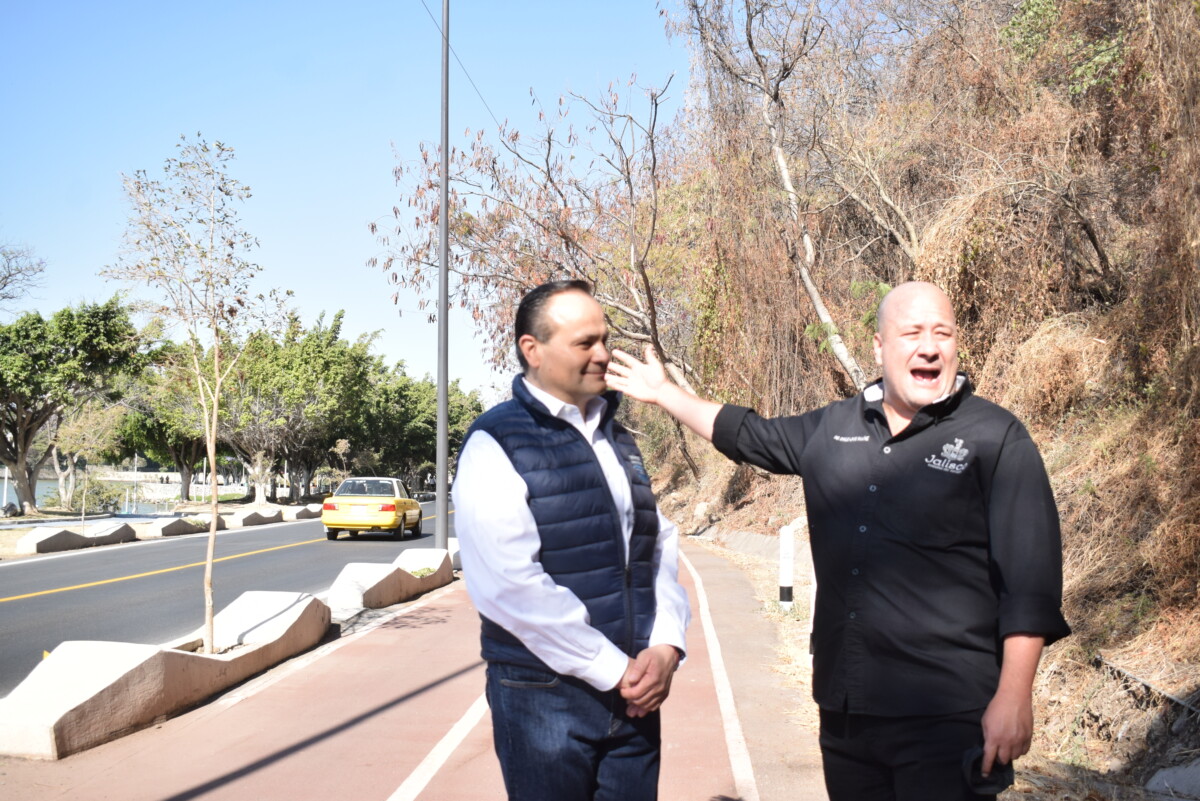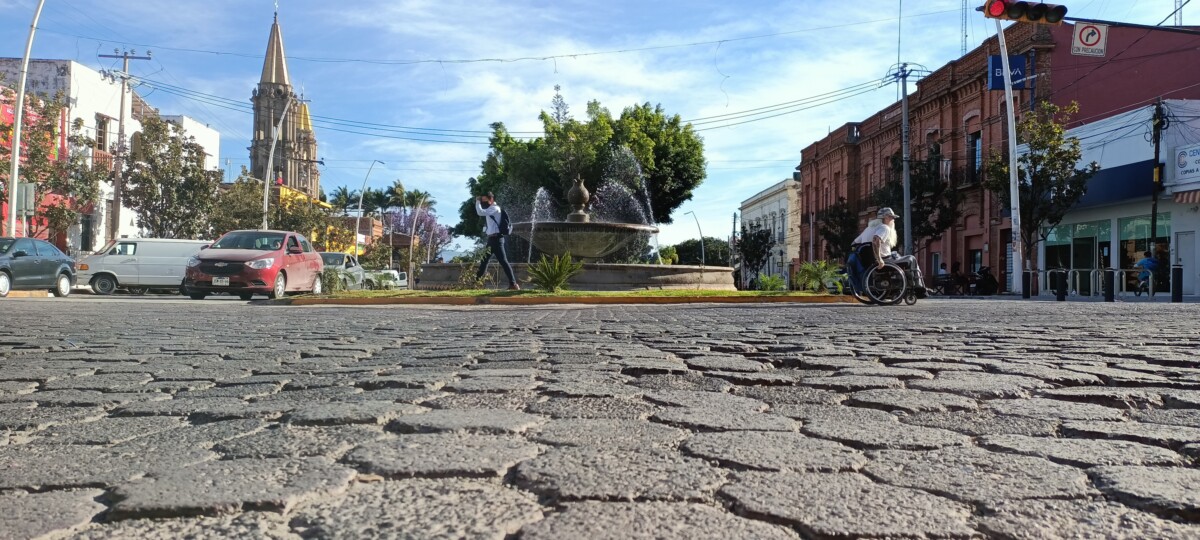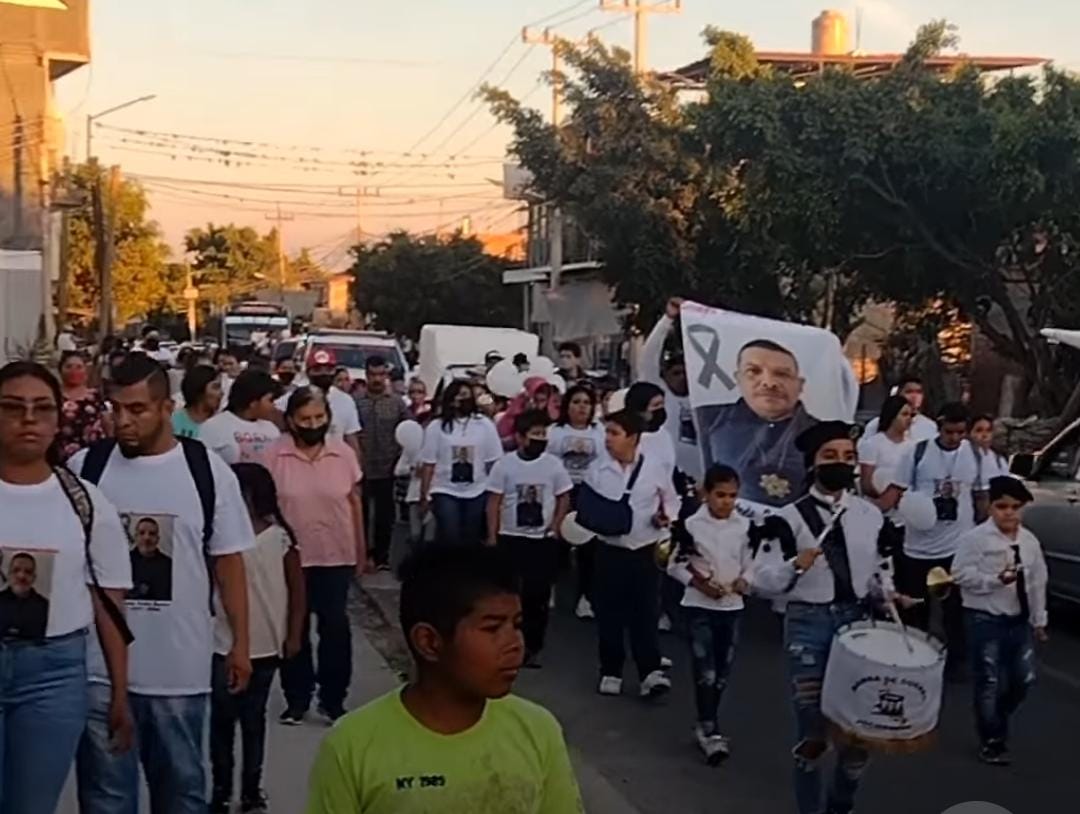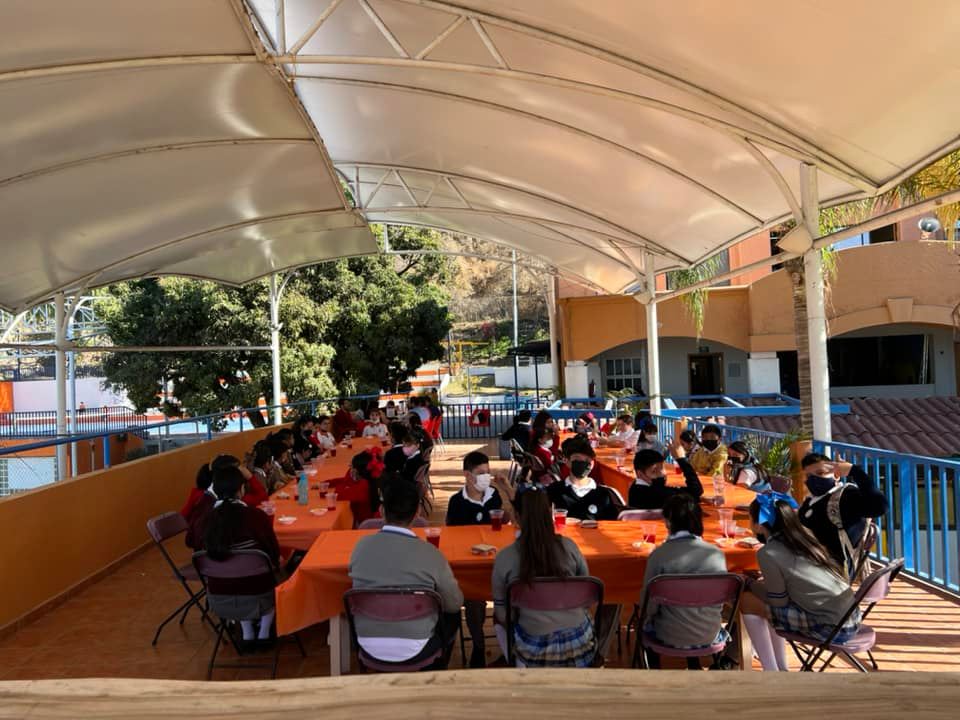Localidades
Governor Alfaro announced the rehabilitation of the Auditorio de la Ribera will be completed by the middle of the year
Architects and those in charge of the work, explained the works to the Governor of Jalisco, Enrique Alfaro Ramírez. Photo: Sofía Medeles.
Sofía Medeles (Ajijic).- After his March 25 tour of the Auditorio de la Ribera in Ajijic, Jalisco Governor Enrique Alfaro Ramírez, announced that the remodeling of the Auditorio will be completed in approximately 4 months.
Although previously, those in charge of the project had said that they had no date for the beginning of the third and last stage of the renovation, Alfaro Ramírez stated during his visit that it should be finished in four months and the cultural center should be up and running by the middle of this year.
«The last stage includes the entrance space, details in the auditorium and adjustments that had to be made at the end, but more than anything else, the entrance, the pond and specialized equipment,» the governor said.
He pointed out that, although 70 million pesos have already been invested in the project so far, a budget for the equipment for the center has yet to be designated.
«A budget is being developed and we are looking to involve the businesses of Chapala that offered to help. The budget will be ready in the following weeks and we will see if the private initiative will lend us a hand. Surely the equipment will also be ready within the remaining four months,» he added.
At the end of the tour of the facilities of the cultural complex, Chapala municipal president Alejandro de Jesús Aguirre Curiel, thanked the governor for the space, asserting that it will be of great importance for Ajijic, which has many talented performing artists and traditions, so it will be a good place for them to continue developing.
Also present during the governor’s visit were Alejandro Guerrero, one of the architects in charge of the project, Lourdes González Pérez, head of the state’s Culture Secretariat, and congresswomen María Dolores «Lolis» López Jara , and Claudia Murguía Torres.
The rehabilitation work began in 2020 and is part of a state project called «Cardinal Culture», which aims to develop cultural activities outside the capital of Jalisco. The auditorium will not only host artistic presentations of different disciplines, but will also host courses, as well as offices of the Jalisco Ministry of Culture.
Translated by Patrick O’Heffernan
Anti-fences movement Back in action!
Approximately 25 people helped in the removal of the cyclone fences. Photo: Sofía Medeles.
Sofía Medeles (Ajijic).– After more than six months of inactivity, the group Pueblos Unidos de la Ribera resumed removing illegal fences on Federal land, this time in the eastern part of Ajijic. The group rallied about 25 people on March 28 to remove two fences that obstructed the passage along the shore of Lake Chapala.
The first fence was located at the end of Donato Guerra street . The group contacted the owner by telephone who claimed to have a concession from the National Water Commission (CONAGUA) and to maintain this fence for the safety of her home. However an agreement was not reached with her to leave the fence intact.
Initially, the woman agreed to show her documents supporting the use of the federal land, but minutes later, she told them that she should not show anything to anyone other than an authority, so the group proceeded to remove the chain-link cyclone fence
During the first demolition, officers of the Chapala police arrived and said that only a report would be made of the action. However, several activists pointed out that they were asked to identify themselves and have their faces photographed. They complained that they felt intimidated by the officers because they were carrying weapons although no weapons were drawn at any time.
Later, the protestors moved further to the east of the town, at the top of Revolucion Street, where a farm under construction had been fenced almost to the edge of the lake. The chain-link was quickly removed, however, the next day it was put up again.

A citizen on horseback supported them by pulling the cyclone mesh to tear it down. Photo: Sofía Medeles.
After the removal of these invasions of federal property, those gathered talked about other points in Ajijic that have the same situation, agreeing to monitor and re-remove fences in the places that had already been liberated to the west of the delegation, as well as to help people from other towns to replicate the «anti-fencing» movement.
» We miss the times when you could walk from Chapala to Jocotepec along the lake shore. Those times will return, if we all unite for this cause, so that our descendants can enjoy the free beaches, which are everyone’s right,» said a member of Pueblos Unidos de la Ribera.
Last April 1st, the activists met again to support residents of the San Antonio Tlayacapan and then continued on to the Pueblo Mágico.
Pueblos Unidos de la Ribera is a movement that was formed early in August 2021. After three actions in which all kinds of fences were torn down on the eastern beaches, between the area of Tio Domingo and Villa Lucerna, they decided to demonstrate at the offices of CONAGUA in Guadalajara.
Although the agency «gave in» and promised to be more attentive to the invasions by deploying more inspectors, in addition to indicating that they were not committing a crime by removing the obstructions, to date, CONAGUA has ignored the agreements.
Translated by Patrick O’Heffernan.
Governor of Jalisco announces investment of 213 million pesos for four projects in Chapala
Jalisco Governor Enrique Alfaro Ramírez together with Chapala President Alejandro de Jesús Aguirre Curiel during the dedication of the 16 kilometers of bicycle lanes in Chapala, in front of La Milagrosa park, at the entrance to the municipal capital. Photo: Jazmín Stengel.
Jazmín Stengel(Chapala).- Jalisco governor Enrique Alfaro Ramírez announced an investment of more than 213 million pesos for four projects during his working tour of Chapala on March 25, 2022. He also inaugurated the Chapala – Jocotepec bike path, toured the 63.32 million pesos rehabilitation of the Auditorio de la Ribera and promised funds for the rehabilitation of the Santa Cruz de la Soledad highway to Ixtlahuacán de los Membrillos.
During his tour he announced the upgrades to Francisco I. Madero Avenue in the municipal capital and, and the Telesecundaria ‘Guadalupe Victoria’ school in Santa Cruz de la Soledad, and more facilities for the Instituto Tecnológico Superior Mario Molina’ campus.
The Instituto Tecnológico Superior will receive 40 million pesos to build 18 new, fully equipped classrooms, multi-purpose rooms and a library. In addition, Governor Alfaro promised to have the Jalisco High Speed Internet Network ready in the next three weeks. This network will also be implemented at the ‘Guadalupe Victoria’ high school.
During his visit to the Telesecundaria in Santa Cruz de la Soledad, the governor said he had spent $12.9 million pesos on the new infrastructure and promised those present to be able to inaugurate the new classroom modules.
Governor Alfaro Ramírez inaugurated the 16 kilometers of bicycle lanes that were built in the municipality of Chapala as part of the state program MiBici. The work that began in 2019, was carried out in two stages with a complementary project that had a cost of 87 million pesos.
The bikeway, which starts in the municipal capital of Chapala and ends at the junction of the Jocotepec beltway along 24.3 kilometers, had a total cost of 211 million pesos, said Enrique Alfaro.
The Governor also announced an upgrade to the entrance to Chapala at Francisco I. Madero Avenue, a 900 meter-long project designed in multiple stages to avoid affecting traffic at Chapala’s busiest intersection. He showed a video detailing how the project would look.
The project has three main objectives. The first is to improve the roadway, replacing the current cobblestones with hydraulic cement and renovating the water and sewage networks that run underneath it. The second is to arrange the parking lot in parallel so that cars «no longer back up» along the avenue, thus avoiding traffic mishaps and maintaining two traffic lanes.
Finally, the project will improve the image of the city’s entrance by installing a fountain on the walkway, almost in front of the San Francisco de Asís parish. It will also extend the bicycle path to the boardwalk, turning the avenue into a «shared street», and modernize the existing outdoor furniture and add new trees.
The 17.5 million-peso cost for the first stage has been secured and the work will begin after the Holy Week-Easter vacations. Although no budget for the total work was disclosed, Chapala Mayor Aguirre Curiel estimated a total cost of approximately 80 million pesos.
A percentage of the still unconfirmed budget will be given to the avenue’s merchants so that they can also improve their image by making it more uniform. This work has been delegated to the Chapala City Council to begin the organization and work with merchants. The construction will be managed by the Secretariat of Infrastructure and Public Works of the State (SIOP).
Translated by Patrick O’Heffernan
Paving stones to be replaced with concrete along Francisco I. Madero Avenue
The project proposes removing paving stone and replacing with concrete on Francisco I. Madero Avenue. Photo: Jazmín Stengel.
Jazmín Stengel (Chapala).- Chapala President Alejandro de Jesús Aguirre Curiel announced that the paving stones along Francisco I. Madero Avenue will be replaced with concrete by the Government of Jalisco in coordination with the Secretary of Infrastructure and Public Works of the State (SIOP).
The 80 million peso project includes the replacement of the paving stone with cement, the restoration of sidewalks and curbs (machuelos), as well as a subsidy to the merchants to upgrade their image along the Avene.
Laguna surveyed local citizens about their response to the project. Of twenty-two people interviewed in a survey in neighborhoods in the western part of the municipality, half said they were unaware of the plans to remodel Chapala’s main avenue, Francisco I. Madero.
While eight of the people informed about the issue were against it, three others approved of the project.
«As long as they do something, they can do it however they want» or «it would be fine,» were the most heard answers during the tour that Semanario Laguna made along the street.
Two of merchants who heard about it disagreed because concrete absorbs heat, is impermeable and its deterioration is more noticeable.
«The paving stone absorbs water, while concrete does not. The paving stone can be repaired in sections,» argued the owner of a veterinarian’s shop on the avenue, who also has a background in engineering.
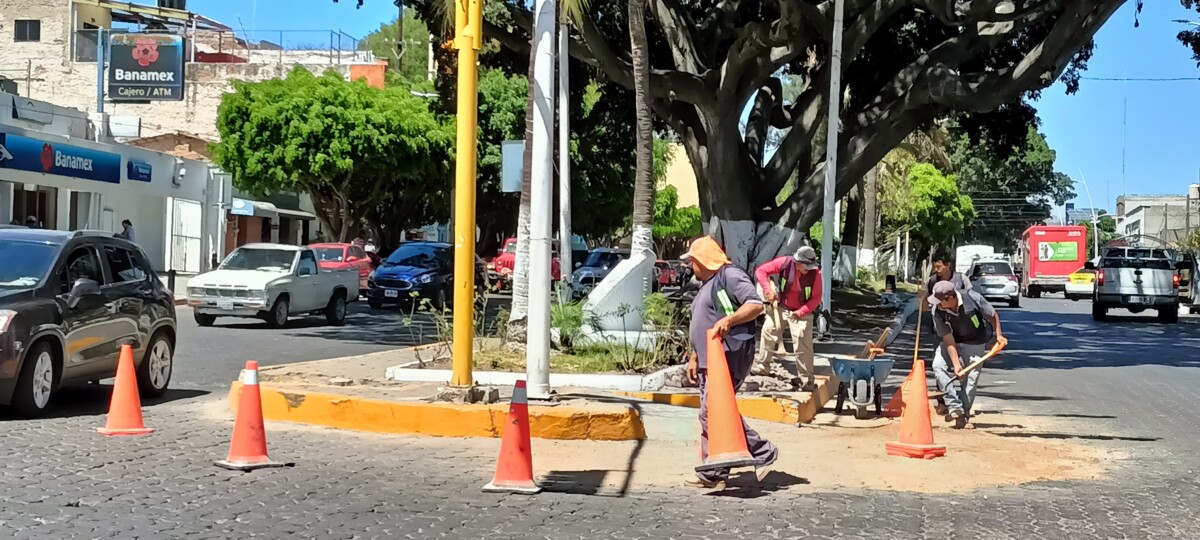
City workers repairing Francisco I. Madero Avenue. Photo: Jazmín Stengel.
A young pharmacist and environmentalist said that these types of materials «affect climate change.”
Others felt that it is an «unnecessary investment» because the paving stone can be lifted in parts, which makes it easier to repair, while the concrete is compacted in one piece, making the deterioration more visible and more expensive to restore, explained a woman interviewed in front of Chapala’s main square.
The project «looks nice, but the joke is that it lasts,» said a vendor near the central plaza. Her neighbor saw the need to give priority to the street repair around downtown, which «looks like you’re riding a donkey” when you drive down the road.
The poor drainage conditions and the slipperiness of the sidewalk tiles also caused a lot of talk. During the rainy season the drains overflow into the commercial businesses in the area.
The sidewalk tiles become slippery when wet, which has already caused several pedestrian accidents, according to neighbors.
«They only fix the showy stuff,» argued Carmen’s husband, accustomed to the fact that public consultations on projects of this type are non-existent in the municipality. To which his wife added: «Hold on! The government always gets its way.»
Translated by Nita Rudy
Lack of working streetlights leaves Chapala inhabitants feeling insecure
One of the private neighborhoods on Pino Suaréz street in the municipal capital. While it is illuminated, it is not enough, according to the neighbors. Photo: Jazmín Stengel
Jazmín Stengel (Chapala).- Although the municipal capital of Chapala has enough streetlights, the inhabitants feel insecure because many of them aren’t working or aren’t well placed, as evidenced by a tour of the San Miguel, Puerta del Horno and Plaza de Toros neighborhoods.
During the tour we interviewed more than 10 pedestrians and neighbors of the area, who said they felt unsafe despite the functioning street lights, explaining that «the lamps do not illuminate where it is most needed.”

The beginning of Privado Aguascalientes with all its lights on. Photo: Jazmín Stengel
On Privada Aguas Calientes and Prolongación Pino Suaréz, two street lights were repaired more than a year ago and have not broken down again, commented one of the neighbors, who pointed out that a well-lit street is safer for both pedestrians and residents.
A little further on, on the third bridge of Pino Suarez Street, the street lights were repaired a few months ago but have not been maintained.

Guayabos Street, one of the darkest streets in the municipality. The neighbors say they have never had electricity here. Photo: Jazmín Stengel
The residents of Guayabos Street, from the intersection with Pino Suarez and Plutarco Elias Calles, stated that they have never had any lighting.
In view of this problem, the coordinator of Municipal Public Services, Jose Antonio Urzua Gracían, stated that he is working full time to solve the lack of lighting in the municipality, despite being left with serious deficits in vehicles and tools since the change of administration.
An analysis made by Antonio Urzua pointed out that in the municipality there are about 6,000 streetlamps, but only 15 to 20 percent were functional when the administration started. «We received a dark municipality, with a great number of complaints,” he said. Six months later they have managed to solve 60 to 70 percent of the problems in the towns of the Chapala municipality.

Jóse Antonio Urzua Gracían, coordinator of Municipal Public Services in the municipality of Chapala, during the interview with Laguna. Photo: Jazmín Stengel
So far, 600 new streetlights have been purchased and 400 more have been repaired by recycling the most useful parts to others, so that only $1,200,000 pesos (about US$60,000) have been spent on repairs, in addition to 400,000 pesos (about US$20,000) on replacing wiring, which is often stolen.
The recycling strategy is useful for saving money, and also to adapt to the lamps already in place. Not all of them are the newer LED technology, and many break down and cannot be repaired due to lack of compatibility with the available parts, or because their life span has been exhausted.
Translated by Sandy Britton
Relatives honor murdered policeman
Relatives of the security officer walked through the delegation of San Juan Cosalá as a tribute on March 21. Photo: Courtesy.
One of the two Jocotepec police officers killed in the confrontation with armed persons on March 10 was finally honored more than 10 days after he died. Relatives of Andrés Inclán Zamora paid tribute to his service as a security officer on March 21.
The municipal president, José Miguel Gómez López, postponed the official tribute due to violence in the municipality since holding an event with crowds of people was considered “high risk.”
Around five o’clock in the afternoon on March 21, Inclán Zamora’s relatives, people from the community and some of his colleagues at the police station celebrated the memory of the murdered policeman. The emotional event, which lasted more than an hour, began on Porfirio Diaz Street in San Juan Cosala. It was attended by about 70 people who, in tears, said goodbye to their friend, brother, family member, father and husband.
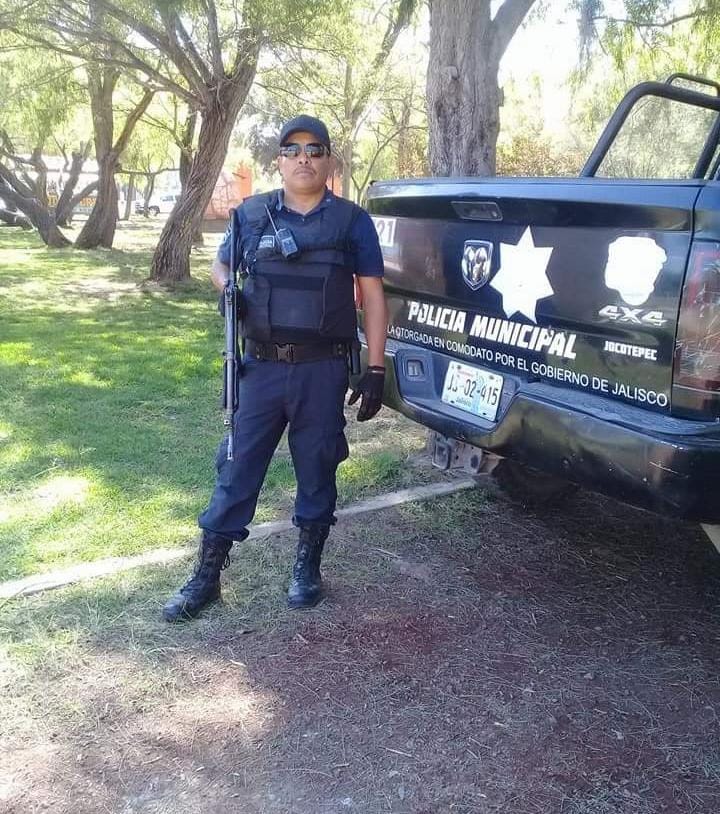
Andrés Inclán Zamora, a 45-year-old policeman, was killed in the clashes on March 10. Photo: Courtesy.
Accompanied at all times by police officers and escorted by a marching band, the relatives of Andrés Inclán recalled with nostalgia and pride stories about the life of the passionate policeman. «He was the oldest of 11 siblings, but he always took care of me and my sisters, he was very good,» said one of his sisters. She added that Inclán Zamora began his police career more than 10 years ago. Although he served as an officer off and on, «it was something he always liked, there is no doubt about that.»
Although his family said that the municipality took care of approximately 60 percent of the funeral expenses, they regretted the position and «silence» of the municipal authorities.
Translated by Elisabeth Shields
Water shortage persists in San Juan Cosalá
Due to the lack of water, neighbors in the center of the delegation have had to pay for water delivery trucks for their water supply. Photo: Alma Serrano.
Alma Serrano(San Juan Cosalá).- Residents of the San Juan Cosalá delegation in the municipality of Jocotepec, have been suffering from a shortage of drinking water for months, and the problem has worsened during the dry season.
Even before the failure of the engine on the Zaragoza well registered on March 13, residents said they live with little availability of the liquid, which has forced them to spend on water delivery trucks to supply their demand.
«I have a lot of water containers to cope with the little water that is arriving, because some days there is no water, some days there is; or a trickle of water arrives all day. It is not enough, we have to pay for water delivery every two weeks or there is no way to bathe or wash the dishes,» said an annoyed citizen.
Those interviewed said they considered it unfair to pay for a service they do not receive. Also, distribution of water in the delegation is unequal, because a few enjoy a lot of water while the majority lives without enough.
«I am not going to bathe in the lake, nor am I going to wash there. Before we did not have to pay for it, but now we pay and they have to send us water in bulk, commented another person affected by the shortage.
The water operator in San Juan Cosalá, Samuel Tolentino, said that after repairs, the Zaragoza well is working again though only at 75 percent of its capacity, which has caused the population to get water by other means. Tolentino considers that the only solution to the shortage is to drill another well.
«The water well (Zaragoza) is working at 75 percent because it is pumping a lot of sand. The solution would be a new well,» he said.
Translated by Elisabeth Shields
Terranova Institute hosts LIMATEJ mathematics test
At least 58 students from public and private elementary schools took the test. Photo courtesy.
Editor.- The Terranova Institute recently hosted the 2022 math skills test of the Jalisco State Mathematics League (LIMATEJ) tournament for elementary school children from school zone 96.
Fifty-eight students from public and private schools took the two-hour test on Wednesday, March 23. One student, Ángela López de la Cerda, solved the test in only 20 minutes. She will represent Terranova in the regional finals.
The tournament, promoted by the Ministry of Education of Jalisco, was held in Terranova Institute’s facilities.
Translated by Mike Rogers
Two minors trapped in nets in lake rescued
The incident remained just a scare.
A tragedy was avoided by Civil Protection and Firefighters after the report of two minors who had entered Lake Chapala in the area of Ajijic, during the afternoon of March 22. The minors were trapped in nets used by fishermen and could not get out of the Lake. Emergency personnel were able to free them, but emergency services were called and arrived with ambulances and firefighters.
Jocotepec police operate in difficult conditions, but new agreement ensures safety
Jocotepec police building located in the municipal capital. Photo: Archive.
Staff.- The killing of two unarmed policemen and the wounding of first responders March 10 on the Guadalajara-Morelia highway height of San Cristóbal, highlighted the fact that the Jocotepec Public Security Corporation, charged with ensuring the welfare of the town and its 13 localities, is operating without necessary equipment or sufficient personnel , and spurred an agreement for joint operations with State Police in the municipality.
The joint operations are designed to insure the safety of the citizens and the officers until the governor and the president obtain additional funding for weapons, equipment and more policemen and policewomen in the municipality.
A former municipal police officer, who preferred to keep his name anonymous for fear of reprisals, said that the police station does not have enough weapons, personnel, or the support of the municipality to carry out its work.
The interviewee described the conditions under which the uniformed officers operate as “precarious,” due to the fact that they lack social security despite the fact that their work serving the community is considered high risk.
«In reality, there are no bullets, only the ones they carry or that they purchase; but the truth is that there are no weapons. In a violent confrontation they would not last five minutes,» said the former police officer.
Although Semanario Laguna sought to confirm the information provided by the former policeman,representatives of the municipality of Jocotepec were not available to answer or comment on the matter.
Resignation of personnel is also a constant problem in the force. In December of last year alone, according to Felipe Aguilar Montes de Oca, former director of social communication, the municipality had only 44 officers distributed in two shifts.
During the March 17 ordinary session of the Jocotepec City Council, municipal president José Miguel Gómez López stated that after the March 10 armed attack that left two policemen murdered, six policemen, as well as commissioner Juan Jesús Hermosillo Moreno, had resigned.
«After the death of the two officers, six more officers resigned from the force. The officers feel unprotected by the lack of equipment, by the lack of protection; situations that are not a direct responsibility of the administration but how resources have been lacking for us to make investments in security,» Gómez López said.
Gómez López explained that because the municipality is officially classified as having a population of less than 50,000 inhabitants, it has not been able to access substantial resources to strengthen the municipal police, although he did point out that they already have life insurance. At its last meeting, the council voted to award the families of the slain officers 100% of their pensions to demonstrate their support for the police and to recognize their bravery.
Translated by MaryAnne Marble and Patrick O’Heffernan
© 2016. Todos los derechos reservados. Semanario de la Ribera de Chapala


